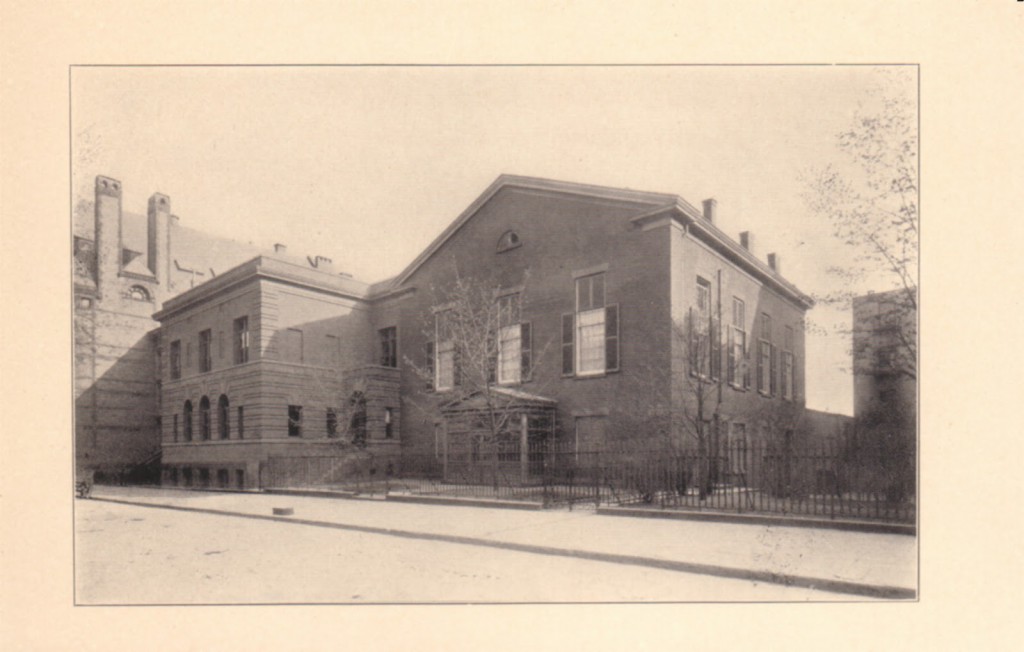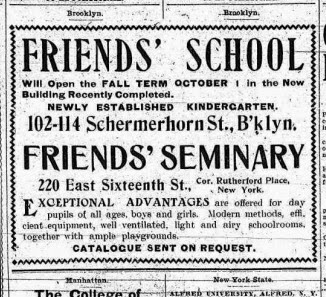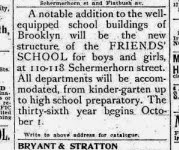Our Buildings, Our History, Part IV: 1902’s Modern Brooklyn Friends School
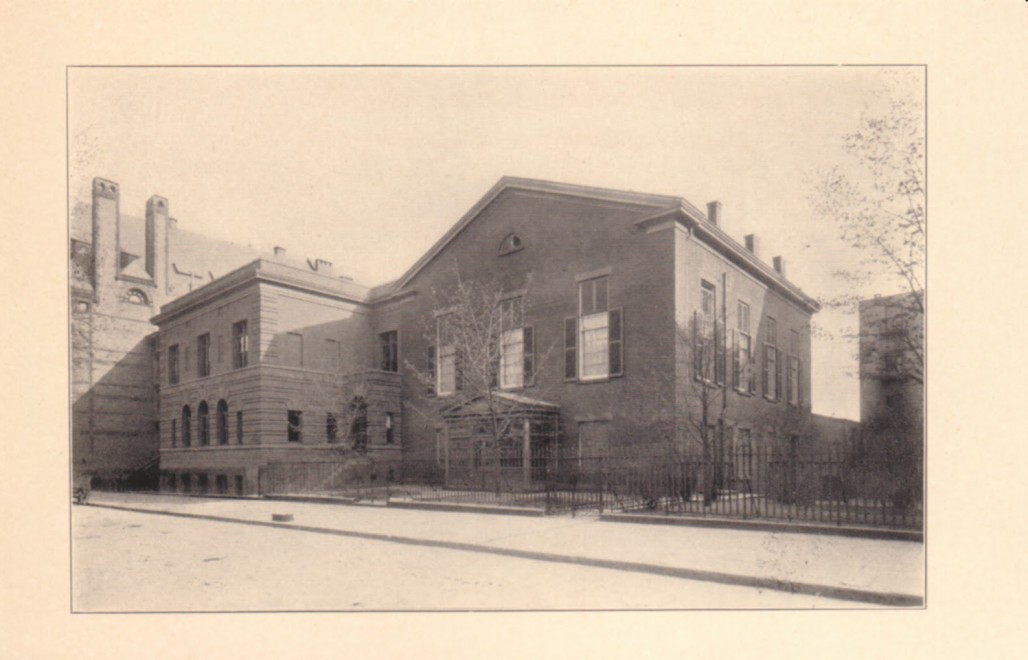
1902 saw one of the biggest moments in Brooklyn Friends School history, our third expansion which created the school building still standing today at 112-114 Schermerhorn, now rented by New York Quarterly Meeting to the NYC Board of Education for Brooklyn Frontiers High School. Today it seems amazing that any building could take only about eight months to build, from concept, to committees, and finally to completion.
This 1902 “main building” enabled the growth of BFS: a serious increase in the student body and the creation of our kindergarten, physical education, manual training (woodworking, basketmaking, sewing, industrial arts), and lunch programs. After 35 years of small-scale excellence, BFS finally would have a dedicated edifice for its scholars. Our 36th year opened a little late on October 1, 1902, but it was in a new and modern school building of its time, with a more up-to-date program. The reinvented Brooklyn Friends School was advertised in the Brooklyn Daily Eagle with true vigor, and our school proved such a success that it was immediately apparent that space requirements for the new school building had been woefully underestimated.
The path to obtaining a new building for BFS in 1902 is in the records of New York Quarterly Meeting of the Religious Society of Friends, then known as New York Monthly Meeting. Brooklyn was certainly growing as a city, but a new school building was the brainchild of the Committee on Increased Social Facilities for the Brooklyn Meeting, a group separate from the Schools Trustees overseeing both Friends Seminary and Brooklyn Friends School. That social facilities committee wanted the Brooklyn Meeting House rooms then used by BFS for the Meeting’s social use and it approached the Schools Trustees who already wanted dedicated quarters for BFS. The proposal for a new school building was approved by all necessary committees and by New York Monthly Meeting itself: a “modern” school building would happen for Brooklyn Friends School and the Brooklyn Meeting House would benefit as well.
Of note is that the Chairman of the Board for the Schools Trustees of New York Monthly Meeting was then William Morris Jackson who lived in Manhattan. His son, Will Walter Jackson, who lived in Brooklyn, was also a Schools trustee, and Will’s oldest child, Morris Bacon Jackson, BFS ’15, would enter the first kindergarten class at BFS in 1902. The Jackson Family was featured in an earlier blog post. The Jacksons were not self-serving when it came to Brooklyn Friends School, they had deep personal ties to Friends Seminary in Manhattan, and members of the Jackson family had taught and graduated from Friends Seminary. The Jackson Family’s stewardship provided for much of the growth and improvements at both BFS and Friends Seminary for many decades. Friends Seminary, also under the Jacksons’ stewardship as Schools Trustees of New York Monthly Meeting, had possessed a kindergarten since 1878, had enjoyed many of the other programs then being planned for BFS for over a decade already, had a high school that BFS students might attend, and Seminary had a history of having more dedicated school space, including its own school buildings (Hester Street location in 1826 and Rutherford Place location with the 1860 move uptown). Additionally, Friends Seminary had been founded 81 years before BFS, so it had enjoyed decades of care and attention from the Meeting. Brooklyn Friends School had been founded as its own school by Brooklyn Quakers and was placed under the care of their Monthly Meeting, the same New York Monthly Meeting that cared for Friends Seminary. One can imagine the thinking of Brooklyn’s Quakers when they founded BFS in 1867 and when they sought to expand, particularly at the turn of the 20th Century: Why should the Quaker children of Brooklyn not get to experience educational opportunities similar to those the Quakers of Manhattan had been receiving for so many years?
When the Property Committee received the proposal for a new BFS building in February, 1902, it was accompanied by plans from Quaker architect John Cox, Jr., an incredibly important person to NYC Quaker history as he was the Records Keeper of New York Monthly Meeting for many years and also authored Quakerism in the City of New York: 1657-1930. The Property Committee had reservations about Cox’s initial plan for BFS, so Cox went back to the drawing board and created a second. Meanwhile, another Quaker architect, William B. Tubby, was also engaged to create another set of architectural plans for consideration. Tubby had designed the small, one-story Brooklyn Meeting House extension of 1886 for Brooklyn Friends School’s use that was to be replaced by this proposed 1902 building. The result of several meetings by several committees was that Cox was paid for his work to that point and Tubby’s plan was chosen for the new BFS building. The 1886 building was demolished, the 1902 building’s entrance was put in its place with the lots purchased in 1888 at 112 and 114 Schermerhorn becoming the rest of the BFS “Main Building.” The boys play yard remained on the west side of the 1857 Brooklyn Meeting House and the girls play yard was behind the 1902 building, where the gymnasium would later be built in 1917.
|
The Brooklyn Daily Eagle 1902 ad announcing the new BFS building.
Never before had BFS run such a series of advertisements.
These smaller ads each ran several times.
|
The budget for the 1902 building was decided by the Property Committee as were the funding sources, all in keeping with the traditions of New York Monthly Meeting at that time: $30,000, with 1/3 to come from the Meeting’s funds for operating expenses and the other 2/3 to come from the Meeting funds held specifically for the Schools. These Meeting funds for the Schools were what is likely the shared endowment for Friends Seminary and Brooklyn Friends School that is still held by New York Quarterly Meeting, and these Schools Funds were actively receiving additional monies primarily from bequests from Quakers, as evidenced in the records of the Property Committee which not only decided how bequests to the Monthly Meeting were to be used and allocated within the Meeting, but also periodically reallocated received bequests from the fund for the Schools to other needs of the Meeting. The final cost of the 1902 building reached $35,000 and that amount included the $2600 for alterations to the Meeting House. BFS seems to have paid for the building’s new furnishings from that year’s tuition receipts. Tubby’s bill for his architectural services was $1600 and the largest expense was $29,000 for the actual builders, Quaker-owned John Thatcher & Sons. The building of 112-114 Schermerhorn seems to have gone off without a hitch: they broke ground on May 19, 1902, the 1901-1902 school year closed early at the end of May, and all was completed in a timely manner for the opening of school a little over four months later. The Brooklyn Daily Eagle’s Educational Directory for that year made mention of the new building, “The two stories and high well lighted basement afford nearly 12000 feet of floor space with ample accommodations for play and physical culture rooms, assembly rooms, class rooms, and especially for the kindergarten department… on the second floor with plenty of sunshine and air.” The 1902-1903 school year began on October 1 and was an immediate success to the point of being too successful.
In those days, Schools Trustees visited the Schools regularly and reported back of their experiences. Sarah Walter Hallock’s visit to BFS was recorded in the Minutes of the Schools Committee on November 29, 1902:
“Each department appears to have settled into admirable working order. The teachers are earnest and interested – the children evidently interested and happy in their work. Everyone who visits the school seems impressed with the spirit of harmony and quiet enthusiasm which pervades it.” And she further noted, “midday lunch proves to be a very comfortable and satisfactory institution.”
 |
| 1902 Brooklyn Daily Eagle ad appealing to non-Quakers. Since its founding, BFS has always been open to non-Quaker families. |
As mentioned in a previous blog post, Principal Susan P. Peckham resigned at the end of the 1901-1902 school year, and it made the newspapers of the day. Our longest serving principal, with 18 years of service, Miss Peckham was apparently opposed to beginning a kindergarten program at BFS, but her desire for the higher salary she felt warranted by an expanding school with a new building was probably the real reason for her very public departure. The Trustees of the Schools refused her salary request and Miss Peckham finished out the year, likely unhappily, and was soon gone. Had she been given the salary of $2000 she wanted, her male counterpart at Friends Seminary, Edward B. Rawson, would have made merely $500 more per year than she at BFS in 1902-1903, that’s about $13,000 today. Seminary had 146 students and BFS only 82 in the 1901-1902 school year, and that changed dramatically with the new 1902 BFS building. BFS and Seminary had nearly the same number of students the next year, with BFS only a K-9 school with the new building, while Seminary had been a K-12 school for several years. Everyone thought the student body would increase some, but not by over 50% and they had to hire more teachers and staff for Brooklyn. The quest for equal pay seems to have always existed between the sexes, and it often existed as well between all levels of the two schools of New York Monthly Meeting: 1902-1903 total salaries at the two schools were apparently BFS at $7,077 for 12 teachers (2 were specialists, likely part-time) and Friends Seminary at $11,512 for 14 teachers (3 were specialists, likely part-time). Decades later, while still under the care of New York Monthly Meeting with Friends Seminary, BFS teachers knew of similar salary differences. In retrospect, Miss Peckham seems to have been justified in asking for an increase in her salary.
Comparing New York Monthly Meeting’s two schools in the Schools Committee Minutes of November 29, 1902:
Seminary: 136 students (25 Friends)
Brooklyn: 130 students (34 Friends)
Seminary: 13 kindergarten, 54 primary, 69 academic (through 12th grade)
Brooklyn: 16 kindergarten, 54 primary, 60 academic (through 9th grade, BFS students of that time apparently only needed two more years of education before being able to attend college)
Our first principal in the new 1902 building was S. Elizabeth Stover, who, for health reasons, had resigned from her position as Friends Seminary associate principal only months before in March, 1902. It is possible that Miss Stover was Seminary’s Lower Division’s Principal, with Mr. Rawson its Upper Division Principal, but no distinction was made on Seminary’s letterhead of the time. Mr. Rawson, of course, became BFS Principal in 1907, the year BFS began its high school program. As BFS principal, Miss Stover made $1500 per year, while Seminary’s principal, Mr. Rawson, made $2500 as recorded in the Minutes of the Schools Trustees Committee for March 28, 1903. Principal Rawson also visited the Brooklyn school that year three times a week to instruct in physical education and 7th and 8th grade manual training. Within a few years, manual training at BFS was taught by Roy McVaugh, who married Miss Elizabeth C. Skinner. Miss Skinner was the first director of the BFS kindergarten in 1902-1903 and she was the founder of our first parent-teacher organization that very same year, the Mother’s Club for the kindergarteners’ mothers, a club that would later become our Parent Teacher Club and today’s PAT.
 |
| 1902 Brooklyn Daily Eagle ad for BFS announcing physical culture, manual training, kindergarten and more |
Principal Stover, 1863-1918 must have been a wonderful person: she was committed to the good works of the Meeting, including Quaker education, and later went into social service work after leaving BFS in 1907. Her retirement from BFS was noted in The Brooklyn Daily Eagle in 1907: “Established forty years ago, this school has always maintained the highest standard… Four years ago, the school was enlarged and moved in to new quarters which gave it the advantage of better equipment, better facilities for maintaining manual training, science and other branches. The society [of Friends] was so fortunate as to obtain the services of Miss Stover to establish the school in its new and charming home. Under her leadership the standard of the school, embracing a course from the kindergarten to the first year’s high school, has been raised.” In addition to her monthly reports to the Board of Trustees of the Schools, Miss Stover wrote a beautiful and less formal letter to the Board shortly after the start of the 1902-1903 school year in which she mentioned there were 12 students in the new kindergarten, but that the number was promising considering that Pratt’s kindergarten had opened years earlier with only four students. In that same letter, Principal Stover also wrote of the new building:
“The new building does credit to architect and builders. It is a beautiful schoolhouse, but it is to be regretted that sufficient accommodation for the Academic Department has not been provided. We are unable without crowding to provide seats for the four highest classes. The increase in our Academic Department was unforeseen and may be in part due to the provision we have made for manual training and physical culture.”
To deal with the crowding in the just-built building, in April, 1903, the Schools Board of Trustees approached the Property Committee with the idea of purchasing the brownstone next door at 116 Schermerhorn as they were seeking “a solution of the problem as to the accommodation of the pupils of the Brooklyn School.” Unsurprising after the expense of the new building that the Property Committee abandoned the idea of that purchase within two months, though the brownstone’s purchase would happen through a gift for BFS over ten years later. The solution that BFS was allowed by the Property Committee was to repartition the new basement dining room for classrooms, and still later in 1905 to configure the never-used gallery above the Meeting Room at the Brooklyn Meeting House into three classrooms, the walls of which seem to still exist today.
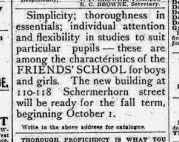 |
| 1902 Brooklyn Daily Eagle ad noting the characteristics of a BFS education |
- The First BFS Buildings – the Brooklyn Meeting House, our first neighbors included a large florists garden and rope manufacturers
- 1867 to 1886 and our 1st expansion – the 1886 extension east of the Meeting House, updated with Principal Peckham’s words of 1886, expressing the good she felt had already come from that smaller capital project for BFS
- Our 2nd expansion in 1888 – the purchase of vacant lots 112 and 114 Schermerhorn, the site of the 1902 “main building” from this article
Have a great summer, friends!

